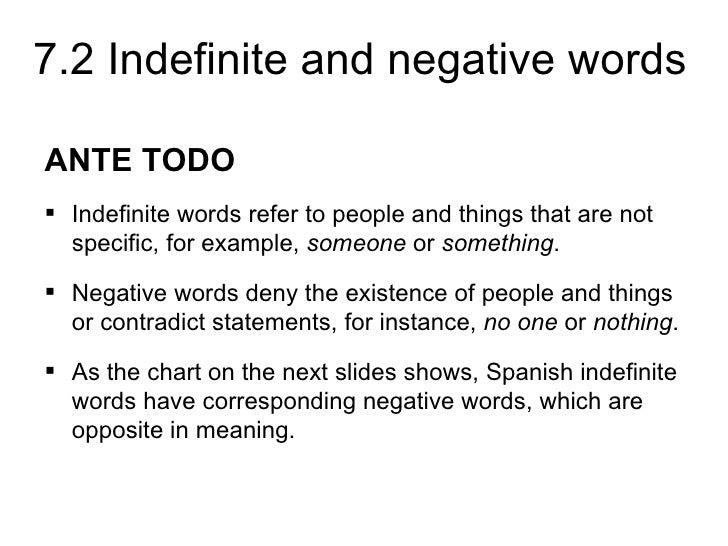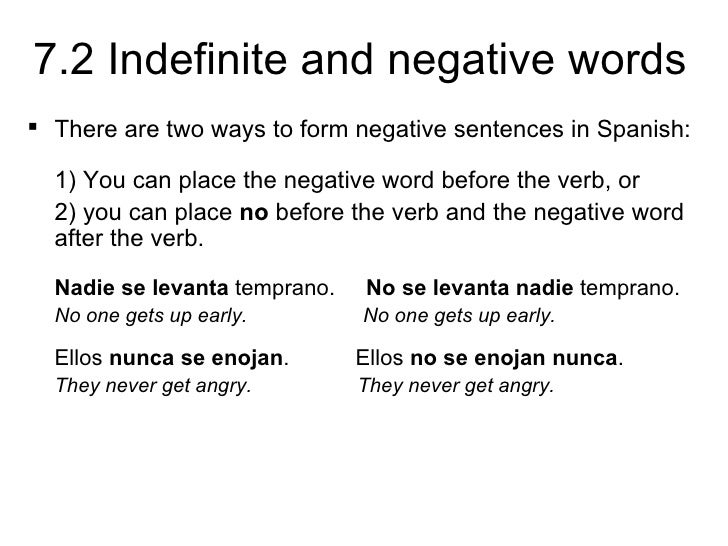
Negative Questions and Answers: Rules and Examples These positive words are also called indefinite words as they refer to persons, things, animals, etc. By replacing a positive word with a negative word, you can turn a positive sentence into a negative one (and vice-versa).
Would you like to learn more travel-related vocabulary in Spanish? Check out these sets of survival phrases and other S.O.S basics !Ģ- Affirmative and Negative Words in SpanishĪnother important thing to remember is that, just like in English, many negative words in Spanish have a positive counterpart. I can’t travel without my favorite sweater. No puedo viajar sin mi suéter favorito. A: ¿Todavía piensas ir a esquiar este invierno?Ī: Are you still planning on going skiing this winter?. I no longer have any cash, I should go to the ATM. Ya no tengo efectivo, debería ir al cajero. ❾ntiendes Aleman? Nosotros tampoco entendemos.ĭo you understand German? We don’t understand either. Your passport hasn’t expired yet, neither has mine. Tu pasaporte no ha expirado todavía, el mío tampoco. A: ¿Tuviste algún problema durante tu viaje?Ī: Did you have any issues during your trip?. A: ¿Qué ciudad te gustó más, Praga o Berlín?Ī: Which city did you like the most, Prague or Berlin?. When using it, you have to change the ending according to the grammatical gender of the noun that follows. * Ninguno is a pretty unique negative word. Neither I nor my sister went to the tour. * When the verb appears before the ni in a sentence, that verb has to be negative. 

Indefinite and negative words spanish worksheet how to#
Below are some examples of how to use the most common Spanish negation words.

Just like in English, there are other words you can use ( never, neither, nobody, etc.) to the same effect. However, placing the “no” before the verb is not the only way to make negative sentences in Spanish. Getting to the train station is not easy.Īs for compound sentences that have more than one verb, you’ll have to place the “no” before the first verb. Llegar a la estación de tren no es fácil. I don’t want to go on vacation to the beach this summer. No quiero ir de vacaciones a la playa este verano. I want to go on vacation to the beach this summer. Quiero ir de vacaciones a la playa este verano. Let’s see some examples of positive sentences turned to negative following this rule: Following this very simple rule, you can start using basic negation in your conversations:

The most basic way to make a sentence negative in Spanish is to place a “no” before the verb and after the subject.
A Few More Negative Expressions in Spanish. Negative Questions and Answers: Rules and Examples. So, keep reading and get ready to improve your Spanish with SpanishPod101! Table of Contents You’ll want to master the art of making negative sentences early on, as they’re essential to even the most basic conversations. …how to use double negatives in Spanish. …how to form negative questions and answers. …the basic negation forms and structures you should know. …the most common negative words in Spanish. The usage of plural nouns is different as well, and of course, exact phrases and expressions differ.īut don’t worry! As always, we’re here to help. For starters, the use of double negatives-which is a grammatical error in English-is considered correct in Spanish and is very common. You should know that there are some grammar rules in English that don’t quite apply in Spanish. The good news is that once you have these rules down, you’ll be able to make negative commands in Spanish, politely decline something, or answer a question in the negative. However, there are some tricks and rules you’ll need to learn in order to master this important aspect of day-to-day conversations. Saying no in Spanish might sound quite easy, especially considering that the word “no” is used in both Spanish and English.








 0 kommentar(er)
0 kommentar(er)
